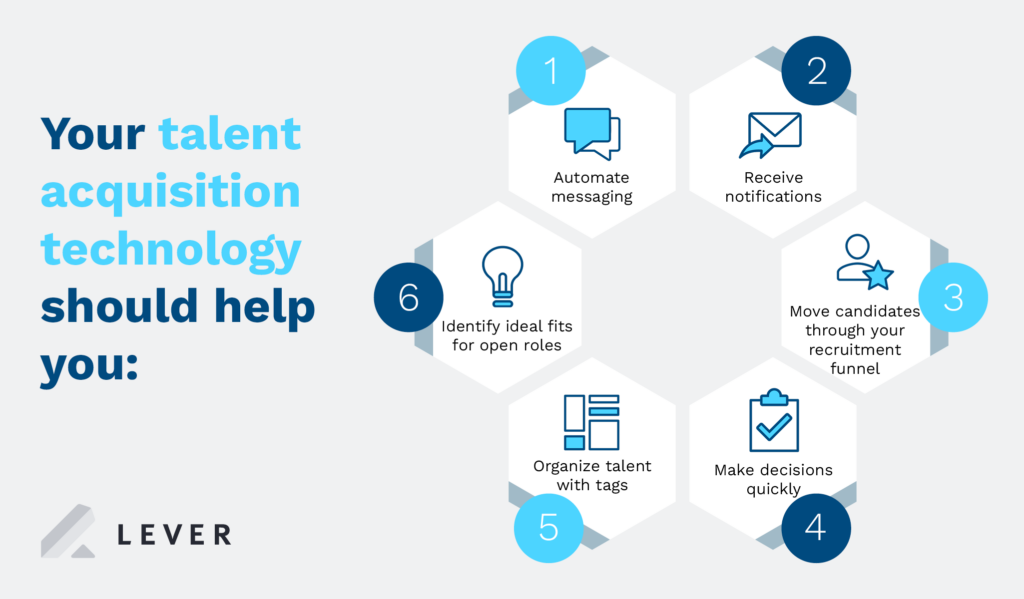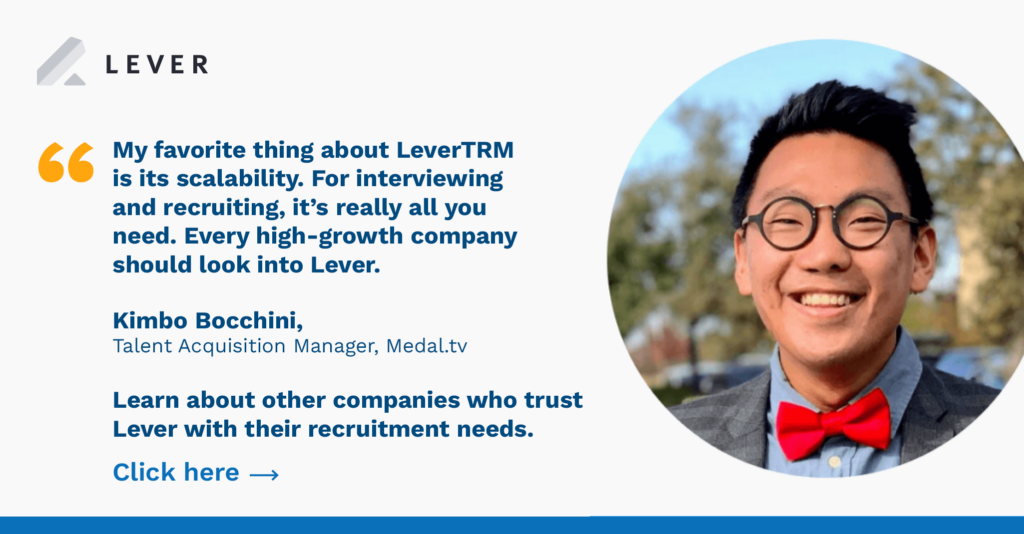A well-executed candidate relationship management (CRM) strategy allows your recruiting team to beat the competition for top talent and engage prospects with ease.
Building relationships with candidates can be challenging, especially in increasingly virtual hiring settings. Talent teams with legacy ATS systems, in particular, historically have struggled to tap into their talent pools to fill open positions.
That’s because basic applicant tracking systems lack the modern recruitment marketing features found in more advanced ATS solutions and complete talent acquisition suites. In this guide, learn how making the switch to modern CRM software can help your talent acquisition (TA) team better source candidates, manage your talent pipelines seamlessly, hire the best active and passive talent, and build long-term candidate relationships.
- What is candidate relationship management?
- Why does candidate relationship management matter?
- Candidate relationship management: 5 strategies for success

What is candidate relationship management?
Candidate relationship management is the process of identifying qualified talent, engaging candidates for open roles, and maintaining a connection with them in the long run to funnel them through your full-cycle recruiting process.
With an optimized CRM approach — and the right candidate relationship management system — you can stay in touch and top of mind with the best fit candidates for your roles. After all, your goal is to hire the best talent, but you must also provide a great candidate experience for current and future applicants.
Why does candidate relationship management matter?
There are times when it’s difficult to source new candidates. For example, during the Great Resignation, nearly 100 million people left their jobs over two years. Leveraging your current talent pool to engage with individuals who have already shown interest in your company can give you an advantage during challenging hiring environments.
In other words, a candidate relationship management approach can help you weather tumultuous recruitment periods, making your talent specialists’ jobs less complex. It can also bolster your employer brand. Satisfied candidates with whom you consistently communicate and who receive a top-tier candidate experience will think highly of your company, even if they don’t end up joining your team.
Candidate relationship management: 5 strategies for success
You can’t build a strong, future-proofed CRM strategy without a coordinated plan that helps you engage candidates in the recruiting lifecycle.
Here are candidate relationship management best practices Lever users abide by when using our native ATS + CRM solution to conduct ongoing outreach with their talent pipelines.
Invest in a recruitment CRM platform with critical capabilities
Sales and Marketing professionals use customer relationship management software to improve how, when, and where they engage potential buyers in the sales funnel.
So, why shouldn’t you have a similar solution to help you better engage and convert talent?
You don’t just need a database to track and store applicants and sourced prospects. You need robust CRM software with functionality that helps you source, nurture, interview, and hire talent in a streamlined, standardized manner.
More specifically, you need talent acquisition technology that helps you:

- Automate most (though not all) of your messaging to early-stage prospects
- Receive notifications when candidates of interest engage with your communications
- Move candidates through your recruitment funnel
- Make decisions about talent quickly and efficiently
- Organize talent with tags in case you want to revisit them for future roles
- Identify ideal fits for open roles in a matter of seconds
This functionality helps fill in the gaps of the recruitment tech stack, helping talent teams achieve success with their candidate relationship management strategies. Ensure your chosen solution is equipped to help you recruit and hire with confidence by researching features and leveraging product demos.

Communicate with prospects in a timely, personalized manner
Communication comes into play at every stage of the relationship-building process.
However, impersonal, generic newsletters or out-of-the-blue emails can turn off candidates from your organization. Contacting candidates directly with 1:1 messaging is how you build genuine human connections with them, but personalizing each communication is time-consuming.
That’s where talent nurturing tech comes into play. For example, LeverTRM expedites communication without compromising personalization by offering pre-made templates, which help recruiters:
- Build and test email programs for consistently better conversion rates
- Customize communications based on roles and departments
- Adjust the number of touchpoints in nurtures, the schedules for sending them, and the copy used to improve over time
Remember, the best CRM strategies recognize and leverage two-way communication. Your candidates may have questions, concerns, or comments about interviewing with you. Relay key hiring process information to talent, while also providing them with feedback channels. Allowing candidates to give feedback will strengthen the bond they feel with your company and can help you improve your candidate experience.

Keep talent engaged through the entire recruitment lifecycle
Your company is considering multiple prospective hires at any given moment, which can mean a lengthy waiting period on your hiring decision.
Though this process may take time on your end, you still need to keep all candidates who participate in your interview process engaged. Many candidates have no shortage of job opportunities, so it’s vital to continually communicate with prospects and keep them updated on the status of your hiring process. After all, when candidates maintain confidence in your hiring process, they are likely to maintain confidence in your company and pass on offers.
To maintain strong candidate relationships — especially with those you mean to employ — you need to have a plan in place that keeps individuals aware of your hiring timeline and when to expect to hear back regarding your decision.
Focus on active and passive candidate relationship management
For roles that are hard to fill, one of your best chances of finding qualified potential fits is to focus on building and nurturing a pool of passive candidates who are suited for these specialized positions.
Passive candidates are candidates that are not necessarily looking for a job right away. That means sources like online job boards may not be the right place to look for passive hires. Instead, try these strategies to access passive candidates:
- Employee referrals. This source is a great way to build a database of passive talent because you already have a connection to future candidates through the referring employee. Offer a small incentive for the referring employee if their recommendation gets hired, such as an extra paid day off or a free lunch, to encourage participation.
- Passive recruitment marketing. Try a marketing approach that advertises both specific roles and your employer brand to individuals in the fields and locations for which you need to hire via paid search ads, social media campaigns, and more.
By paying attention to both active and passive prospective hires, you can keep interest in your organization and roles high. Just ensure that you’re available to answer passive hires’ questions as they might be less familiar with your brand than active prospects.
Demonstrate transparent and ethical hiring practices
Welcoming all applicants, regardless of their background, is crucial for building a diverse workforce and spurring innovation at your organization. Diversity, Equity, and Inclusion (DEI) initiatives and other ethical hiring practices can mitigate biases and other barriers to facilitate an accepting workplace. Consider implementing these best practices to improve your hiring process:
- Outline the hiring process upfront. Provide clear expectations about which materials to submit and what the hiring process involves.
- Share insight into company culture. Offer information about your culture and the collaborative aspects of the workplace, so the candidate understands what the day-to-day aspects of the job would look like.
- Adopt bias-blind hiring practices. Remove identifiable aspects of each candidate’s resume, such as their name and gender, so you avoid the impacts of unconscious bias and select candidates purely based on their qualifications.
- Publish accurate job descriptions. Posting precise job descriptions saves both your team and your candidates time by weeding out bad fits from the beginning.
- Encourage questions and open dialogue. Ensuring applicants feel comfortable and heard increases the likelihood that they’ll accept your offer if you extend one.
- Stick to a timeline. If you have to deviate from the outlined hiring timeline, be upfront with the applicant, so they aren’t left on the hook.
Treating your candidates with respect has short- and long-term benefits for your organization: it increases the likelihood of them signing on to work with your company and staying loyal to your organization over time.
Improve candidate experience with data
Like any other process, you can enhance the candidate experience with actionable insights based on data. Here’s how you can use your CRM system to try data-driven strategies:
- Leverage specific features for reporting and data collection.
- Set relevant KPIs, such as candidate satisfaction score, application completion rate, time to fill, offer acceptance rate, and drop-off rate.
- Analyze quantitative feedback via surveys and exit interviews.
This strategy hinges on your team effectively using a powerful CRM system. Pairing your chosen system with data hygiene best practices, such as regular audits and standardized formatting, helps you ensure a seamless data-driven candidate experience.
Explore your current system and determine how it can support these best practices. If you find your current solution doesn’t have what you need, it might be time to upgrade to a talent acquisition suite like Lever.



